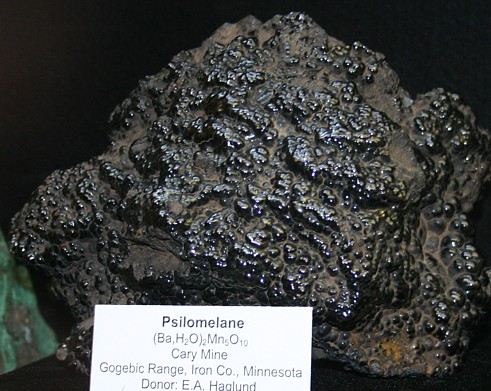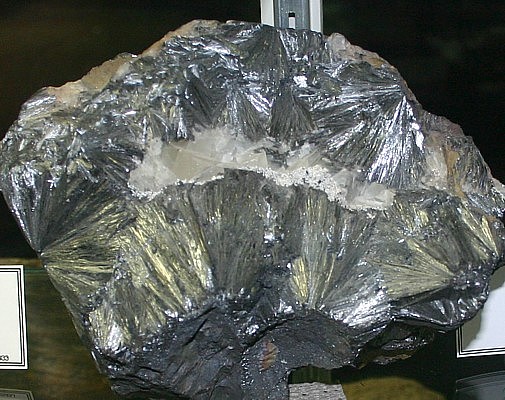Manganese is an element
that is widely distributed in small amounts. Traces of it at least are to be
found in most rocks. Manganese makes up about one part in 1000 (0.1%) of the
Earth's crust, making it the 12th most abundant element. It most commonly
occurs in silicates, oxides and carbonates. The oxides are the most
abundant, and practically all of the metal is derived from them. The chief
sources of manganese and its salts are the oxide minerals.
Pyrolusite is also used, as such, for a number of purposes,
such as the decolorization of glass, as a dryer in the manufacture of paint
and varnish, and in dry batteries, and very largely for the manufacture of
chlorine, bromine, and oxygen, of permanganates and other manganese
compounds. The permanganates of sodium and potassium are used as
disinfectants. Salts of manganese are also used for coloring bricks, pottery
and glass.
Manganese does not occur in uncombined state in nature, but may, like
chromium, be produced in the electric furnace and by the Thermite process
(see under Aluminum ore). It is a light, pinky-grey metal, melting at about
1,900 C., and having a specific gravity of about 7.5 the manufacture of
alloys, such as spiegel-eisen and ferromanganese, containing from 15 to 80
per cent, manganese, and silico-manganese, containing from 15 to 25 per
cent, silicon, all of which are used, and are of great importance in the
steel industry. These alloys are extensively used in the manufacture of
steel because they serve to take away any oxygen that might be in the iron,
the oxygen uniting with the manganese and going into the slag. They serve
also to introduce carbon into the steel and to prevent its oxidation, and
also to counteract the bad effects of sulphur and phosphorus. Manganese has
also of itself a hardening influence on steel. For these reasons manganese
steels have a wide use.
For chemical uses, a high percentage of manganese in the form of peroxide is
demanded, 80 percent manganese being taken as the basic standard. Lime
should be present in quantities less than 2 per cent. For metallurgical
purposes 50 percent manganese is a common basis. Manganese ores which are a
combination of iron and manganese are smelted direct for the production of
manganese pig-iron, but such ores should be regarded as iron ores, and the
manganese would not be paid for except at the same rate as iron. The world's
production of manganese ore is mined in South Africa, Australia, China,
Brazil, Gabon, Ukraine, India and Ghana. The chief producers are South
Africa, Australia, China and Gabon.
Manganese is very widely distributed, and replaces to a greater or lesser degree two sets of elements: First, the alkaline earths, calcium, barium, and magnesium; and secondly, aluminum and iron. Purely manganese minerals of the greatest importance are the oxides, others are the carbonate, silicate, and sulfide. Important manganese minerals include Hausmannite, Braunite, manganite, Pyrolusite, Polianite, psilomelane, rhodochrosite, Rhodonite, Alabandite. Manganese minerals occur in very varied ways. Rhodochrosite and rhodonite occur as veinstone gangue in some silver lodes, the gossan of which carries the oxide minerals, pyrolusite, psilomelane, etc. Rhodochrosite also occurs as a metasomatic replacement of limestone. The most important and interesting deposits of manganese, however, are those of the oxides of sedimentary, or residual origin. Tests for manganese minerals give distinctive bead reactions. The borax and microcosmic-salt beads are reddish-violet in the oxidizing flame and colorless in the reducing flame. The sodium-carbonate bead is bluish green.
While many different minerals contain this metal, practically the only ones of commercial value are the oxides and carbonates, and in this country only the former. The silicates are not used as a source of manganese, owing to their high silica percentage. The manganese ores proper consist usually of a mixture of oxides, and indeed these compounds are really the only ones of importance in the United States. Pyrolusite and psilomelane are by far the most important, and are often intimately associated, the pyrolusite generally assuming a crystalline and the psilomelane a massive structure. They may locally have some admixtures of iron oxide, and then they are of use in the steel industry, but when free from iron they are, in addition, of value for oxidizing and coloring purposes. Wad is often of too low grade, due to impurities, to be used as an ore of manganese, but it is sometimes employed for paint. Rhodochrosite, though found as a common gangue mineral in some western mines (Rico, Colorado; Butte, Montana, silver mines), can hardly be regarded as a source of manganese. It has, however, been mined in some quantity in the Huelva district of Spain, and in Merionethshire, Wales.
Manganese oxides, in addition to being associated with iron, as noted above, are sometimes mixed with zinc or silver. It is customary, therefore, to make a fourfold division into (1) manganese ores, (2) manganiferous iron ore, (3) manganiferous silver ore, and (4) manganiferous zinc residuum. Manganiferous iron ores found in the United States consist chiefly of limonite or hematite mixed with psilomelane, pyrolusite, or wad, the mixture being an intimate one. The high-grade ores are of value for making spiegeleisen or ferro-manganese, but in those running low in manganese this element is usually regarded as an impurity
Manganiferous silver ores are composed of a mixture of manganese and iron oxides, containing small amounts of silver minerals, lead carbonate, and sometimes even gold. In this class of ores, in which the iron usually predominates over manganese, the ores form the gossan of metallic sulphide bodies carrying iron, lead, zinc, and silver sulfides in a quartz or calcite gangue. Rhodonite and rhodochrosite sometimes occur in the unaltered ores. The most important deposits of manganiferous silver ores are those found at Leadville, Colorado. Manganiferous silver and iron ores are important in the oxidized zone of the Leadville district, forming large masses adjacent to the sulphide deposits. Some have suggested that they represented infiltrations from the porphyry, but it has been shown that manganiferous siderite in irregular masses is abundant as a limestone replacement. It is therefore suggested that weathering of the siderite has yielded the manganese. The ores contain silver and a trace of gold. Ores of similar character are found at Neihart and Castle, Montana. Manganese is also found in the silver veins at Butte, Montana, but is of little commercial value. Still other manganiferous silver ores have been noted from scattered localities in New Mexico, Arizona, Utah, and Nevada, but appear to be of little commercial importance. Some found in the Tintic district, Utah, are used as flux at the local smelters.
Manganese ore deposits of the oxide type are usually of secondary origin, having been formed by weathering processes, which caused the decay of the parent rock containing manganiferous silicates, and the change of these latter to oxides. By circulating ground water they have often been concentrated in residual clays. Although iron also may have been present in the parent rock, and the two are sometimes deposited together, still they have in many instances been separated from each other, due to the fact that conditions favorable for precipitation are not the same for both, or because the soluble compounds of manganese formed by weathering are sometimes more stable than corresponding iron compounds, and hence may be carried farther by circulating waters before they are deposited. Manganese oxides may be precipitated from sea-water, as nodules of this composition have been obtained by dredging from the sea bottom. By the upraising of these deep-sea deposits are formed many of the bodies of workable manganese. Another of this class of manganese deposits is formed by precipitation of manganese oxides in lakes, etc., by the action of minute plants, giving rise to the bog-manganese deposits, as in Sweden, Spain, and the United States.
The second type of manganese deposit is formed by the alteration of rocks containing manganese-bearing minerals, silicates, etc. By the weathering of such rocks the manganese aggregates together as nodules and layers in the residual clay, which forms on the outcrop of weathered rock. Thus is formed a residual or lateritic deposit; such deposits are worked in India, Brazil, and Arkansas. It will be seen that all deposits of manganese oxides have been formed by the breaking up of the manganese bearing minerals of igneous and metamorphic rocks. By the metamorphism of sedimentary or residual manganese deposits there are formed workable deposits of hausmannite, braunite, and franklinite, as in Sweden, Piedmont, and at Franklin Furnace, U.S.A. Although the manganese-bearing ores are widely distributed in the United States, only a few localities are of commercial importance, and there has been no manganese mining industry in the US for several decades.
Return
to Metal Ores Page:
Precious and Base Metal Ores

Psilomelane is a less common Manganese ore that is sometimes used in the manufacture of various manganese chemicals and steel alloys.

Pyrolusite is the major ore of manganese and is used in many ferro-manganese steel alloys and glass de-colorization.
